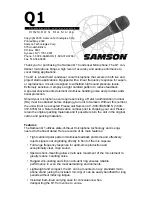
SCHOEPS
GmbH · Spitalstr. 20 · D-76227 Karlsruhe (Durlach) · Tel: +49 721 943 20-0 · Fax: +49 721 495 750
www.schoeps.de · [email protected]
Suggested applications / Connecting / Operation
11
English
The Cable
Ordinary analog XLR cable can be used, but
its characteristic impedance is undefined; thus
we cannot guarantee reliable operation of the
microphone particularly with long cables. If an
AES3-standard XLR-3 cable with a characteristic
impedance of 110
Ω
is us ed, then operation
at lengths of up to 300 m (nearly 1000') is
pos s ible.
Power-on Behavior
When powered on, the SuperCMIT may
require up to 15 seconds to become ready for
use. Varying amounts of noise may be pro-
duced during this time; such behavior is
entirely normal.
Operation
The SuperCMIT has two output channels:
Channel 1: ”SuperCMIT” (enhanced directivity;
processed signal from both transducers)
Channel 2: ”CMIT” (normal directivity;
unprocessed signal from the front-facing
transducer)
Both channels are affected simultaneously by
the filter switches.
Green LED = ”Filter off”, red LED = ”Filter on”
High-frequency boost
: +5 dB at 10 kHz – to
compensate for losses due to windscreens
Steep low-cut
: 18 dB/Oct. below 80 Hz – to
suppress wind and boom noise
The
Preset button
selects the directivity of the
”SuperCMIT” (Channel 1):
– Preset 1 (green LED): Increased directivity;
11 dB suppression of diffuse sound, which
is 5 dB greater than CMIT.
directivity
(Preset)
high-frequency boost
low-cut
Suggested applications
The SuperCMIT 2 U is suggested for use wher-
ever there is interference from diffuse sound
such as street noise, rustling leaves, wind noise,
sound from passers-by or onlookers, or room
reverberation in a recording. The interfering
sound is reduced significantly in level without
affecting the sound color of directly arriving
sound, even down to the lowest frequencies.
This makes the SuperCMIT ideal e.g. for diffi-
cult film sound assignments and sports broad-
casts.
The SuperCMIT also extends ”reach” for
indoor recordings.
Connecting the SuperCMIT
Input / Powering
The SuperCMIT's output is digital, complying
with AES42, Mode 1. It requires digital phan-
tom powering (10 V), which is supplied via
the signal cable as with analog microphones.
Because it operates in Mode 1, the micro-
phone provides its own clock (48 kHz). Thus
the input of the interface device or recorder
must provide sampling rate conversion if the
microphone is to be operated synchronously
with other equipment.
AES42 Mode 1 inputs are available on cer-
tain equipment, e.g. the 8-channel DMC-842
interface from RME and the Sound Devices
788T 8-channel portable recorder. For further
information please see www.schoeps.de/
digital and www.hauptmikrofon.de/aes42.
The SuperCMIT can also be used with AES3
inputs if digital phantom powering is supplied
(e.g. by the PSD 2 U – see ”Accessories”)
between the input and the microphone.
channel 1
channels
1 and 2


























